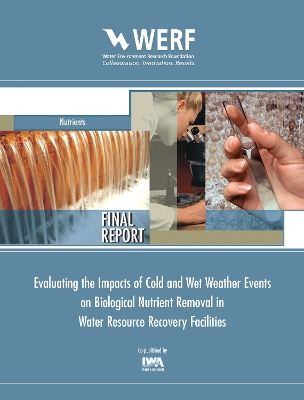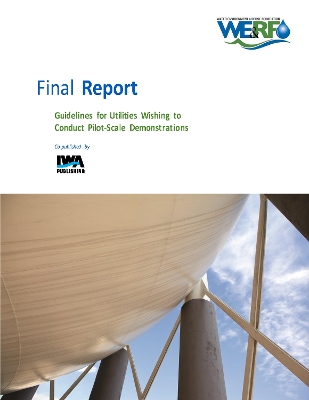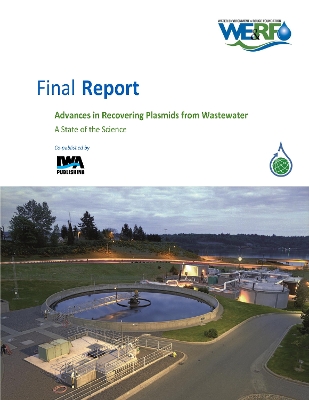WERF Research Report
4 total works
Maintaining effective biological nutrient removal (BNR) capability during adverse weather events can be challenging for water resource recovery facilities (WRRF). Mitigation of the impact of these weather events on BNR requires focused strategies that are known to be effective. In this study, the researchers worked with twelve WRRFs that experience cold wet weather events to identify critical challenges they face when attempting to maintain optimal BNR performance during these weather events. As part of this work, the project team also compiled and evaluated strategies that are currently implemented by BNR facilities for mitigating these impacts. Results from these evaluations indicate that resistance to and recovery from cold wet weather events is closely linked to plant ability to protect and maintain sufficient mixed liquor concentrations and solids retention times for biomass growth. Therefore, strategies that employ biomass storage and recirculation are effective for helping plants maintain BNR capacity during and after cold wet weather events.
ENER11R13
Guidelines for Utilities Wishing to Conduct Pilot-Scale Demonstrations
by Lori Stone and Wendell Khunjar
Published 15 September 2016
As stewards of public funds, Water Resource Recovery Facilities (WRRFs) can be conservative in their approach to new technologies and processes, which hinders the advancement of technology and limits beneficial returns. This reluctance can be overcome by reducing perceived complexity surrounding pilot-scale projects, and by demonstrating applicable technologies, costs, and logistics. Sharing and documenting the lessons learned from conducting demonstration projects can encourage utilities to consider new technologies and increase confidence in decision-making.
WERF's experience with utilities engaged in the Leaders Innovation Forum for Technology (LIFT) focus groups indicates that the utilities may be inexperienced with new technologies and unfamiliar with the steps required for a successful demonstration project that empowers the utility with enough information to make informed decisions on new technologies. This project will examine the perceived and real complexities in conducting demonstration studies by featuring industry-relevant examples to elevate understanding of technologies, performance expectations, and implementation processes.
WERF's experience with utilities engaged in the Leaders Innovation Forum for Technology (LIFT) focus groups indicates that the utilities may be inexperienced with new technologies and unfamiliar with the steps required for a successful demonstration project that empowers the utility with enough information to make informed decisions on new technologies. This project will examine the perceived and real complexities in conducting demonstration studies by featuring industry-relevant examples to elevate understanding of technologies, performance expectations, and implementation processes.
NTRY1R12b
Towards a Renewable Future: Assessing Resource Recovery as a Viable Treatment Alternative
by Ronald Latimer and Wendell Khunjar
Published 15 March 2016
Extractive nutrient recovery, defined as the production of chemical nutrient products devoid of significant organic matter, represents a complementary strategy for managing nutrients in multiple waste streams. In this option, energy and resources are used to accumulate and produce a chemical nutrient product that is recyclable and has a resale value that could potentially help offset operating costs while reducing nutrient production from raw materials for agricultural or other uses.
This report (NTRY1R12b) presents a compilation of case studies of water resource recovery facilities (WRRFs) at various stages of implementation of extractive nutrient recovery technologies in the form of struvite crystallization. Of the 20 WRRFs identified in this report, six have implemented or are implementing a struvite crystallization facility and seven have performed desktop and/or pilot evaluations. Data from these thirteen utilities were used to develop the Tool for Evaluating Resource Recovery-Phosphorus (TERRY-Phosphorus), which was used to perform a conceptual level evaluation of implementing struvite recovery at seven other WRRFs.
Data from the full-scale WRRFs that have implemented struvite recovery indicate that sidestream soluble phosphorus removals ranged from 80 to 90%, while ammonia removal ranged from 7 to 30%. Struvite production ranged from 64 to 421 metric tonnes per year and was found to be dependent on the site specific conditions and technology employed. Drivers for implementing nutrient recovery included reduction in supplemental carbon requirements for nitrogen removal, reduction in aeration requirements, reduction in biosolids production versus conventional treatment alternatives, reduction in costs associated with mitigating nuisance precipitate formation, benefits to sludge dewaterability, and benefits associated with manipulating the N and P content of the biosolids. Quantifying the economic and non-economic benefits of these drivers together with site specific factors can help drive the implementation of resource recovery systems at full-scale WRRFs.
This report (NTRY1R12b) presents a compilation of case studies of water resource recovery facilities (WRRFs) at various stages of implementation of extractive nutrient recovery technologies in the form of struvite crystallization. Of the 20 WRRFs identified in this report, six have implemented or are implementing a struvite crystallization facility and seven have performed desktop and/or pilot evaluations. Data from these thirteen utilities were used to develop the Tool for Evaluating Resource Recovery-Phosphorus (TERRY-Phosphorus), which was used to perform a conceptual level evaluation of implementing struvite recovery at seven other WRRFs.
Data from the full-scale WRRFs that have implemented struvite recovery indicate that sidestream soluble phosphorus removals ranged from 80 to 90%, while ammonia removal ranged from 7 to 30%. Struvite production ranged from 64 to 421 metric tonnes per year and was found to be dependent on the site specific conditions and technology employed. Drivers for implementing nutrient recovery included reduction in supplemental carbon requirements for nitrogen removal, reduction in aeration requirements, reduction in biosolids production versus conventional treatment alternatives, reduction in costs associated with mitigating nuisance precipitate formation, benefits to sludge dewaterability, and benefits associated with manipulating the N and P content of the biosolids. Quantifying the economic and non-economic benefits of these drivers together with site specific factors can help drive the implementation of resource recovery systems at full-scale WRRFs.
NTRY8R15a
Advances in Recovering Plasmids from Wastewater: A State of the Science
by Kevin Gilmore, Samuel Jeyanayagam, Wendell Khunjar, and Thomas Worley-Morse
Published 15 September 2016
Plasmids are small rings of double stranded DNA that are found in all three domains of life: the Bacteria, the Archaea, and the Eukarya. Plasmids encode for proteins that provide their host organisms multiple abilities, such as the ability to transfer genetic information, degrade xenobiotic compounds, resist antibiotics, and outcompete other cells. Plasmids are similar in size to viruses, mostly in the submicron size range; however, plasmid size is normally described by the number of DNA base pairs as opposed to the physical size.
Although plasmids are found in all three domains of life, plasmids are most commonly associated with bacteria. Because wastewater harbors bacteria and WRRFs harness bacteria for biological treatment processes, wastewater contains a variety of plasmids and plasmid hosts. Sources of plasmids in wastewater include bacteria excreted from humans and bacteria present in the environment. Researchers have found high levels of bacteria with antibiotic resistant plasmids in the fecal matter of antibiotic-treated children and adults. Bacterial hosts transport plasmids throughout wastewater treatment processes, and as bacteria die and rupture the plasmids are released into the wastewater. Although research suggests that naked plasmids degrade in wastewater, WRRF effluents and biosolids have been shown to contain plasmids and may contribute to the spread of antibiotic resistance.
Plasmids and their associated genetic information represent a potential recoverable resource from wastewater. These small rings of intracellular DNA not only encode the genes that facilitate their own transfer and propagation but also harbor functional genes related to a variety of processes. The biotechnology industry has harnessed the information on plasmids to improve multiple industries, such as agriculture, chemical production, paper, textiles, health care, environment, and biotechnology. Plasmids that function to produce antibiotics, degrade xenobiotic compounds, and serve as biocatalysts have been isolated from wastewater. At the same time, the purposes and functions of significant proportions of plasmid DNA recovered from wastewater samples remain undetermined and represent an unknown value to society. Nevertheless, research suggests that wastewater contains genetic information that is of value to society.
Plasmids are unlike traditional recoverable commodities, because they are not sold by weight. The information encoded on plasmids and the intellectual property protections provide the value. The actual plasmid has little to no value. Therefore, traditional methods for valuing resource recovery are not transferable to plasmids, as bulk plasmids with no information on the encoded functions or intellectual property protection have little to no value. Hence, a methodology for valuing plasmids must involve sequencing and/or culture-based determination of the gene functions available thereon. Once determined, plasmid products suitable for market could take one or more of several forms, consisting of the plasmid itself, its intellectual property rights, the products of its functional genes, or any combination of the above.
Plasmid based products, such as enzymes, are used in multiple industries. Using market estimates from multiple biotechnology sectors, the market for plasmids and plasmid based products and intellectual property could be expected to grow between 5% and 10% combined annual growth rate, and the biotechnology sector has a current value of greater than $270 billion. Yet plasmid recovery, if evaluated using an 'expected value' economic approach, likely represents a net loss for WRRFs at this time due to the substantial risks and capital costs involved compared to the potential returns. As a result, plasmid recovery and the recovery of genetic materials from municipal wastewater is a long-term objective, and a pathway for developing the product recovery potential of plasmids is provided over a 20-year time horizon.
Although plasmids are found in all three domains of life, plasmids are most commonly associated with bacteria. Because wastewater harbors bacteria and WRRFs harness bacteria for biological treatment processes, wastewater contains a variety of plasmids and plasmid hosts. Sources of plasmids in wastewater include bacteria excreted from humans and bacteria present in the environment. Researchers have found high levels of bacteria with antibiotic resistant plasmids in the fecal matter of antibiotic-treated children and adults. Bacterial hosts transport plasmids throughout wastewater treatment processes, and as bacteria die and rupture the plasmids are released into the wastewater. Although research suggests that naked plasmids degrade in wastewater, WRRF effluents and biosolids have been shown to contain plasmids and may contribute to the spread of antibiotic resistance.
Plasmids and their associated genetic information represent a potential recoverable resource from wastewater. These small rings of intracellular DNA not only encode the genes that facilitate their own transfer and propagation but also harbor functional genes related to a variety of processes. The biotechnology industry has harnessed the information on plasmids to improve multiple industries, such as agriculture, chemical production, paper, textiles, health care, environment, and biotechnology. Plasmids that function to produce antibiotics, degrade xenobiotic compounds, and serve as biocatalysts have been isolated from wastewater. At the same time, the purposes and functions of significant proportions of plasmid DNA recovered from wastewater samples remain undetermined and represent an unknown value to society. Nevertheless, research suggests that wastewater contains genetic information that is of value to society.
Plasmids are unlike traditional recoverable commodities, because they are not sold by weight. The information encoded on plasmids and the intellectual property protections provide the value. The actual plasmid has little to no value. Therefore, traditional methods for valuing resource recovery are not transferable to plasmids, as bulk plasmids with no information on the encoded functions or intellectual property protection have little to no value. Hence, a methodology for valuing plasmids must involve sequencing and/or culture-based determination of the gene functions available thereon. Once determined, plasmid products suitable for market could take one or more of several forms, consisting of the plasmid itself, its intellectual property rights, the products of its functional genes, or any combination of the above.
Plasmid based products, such as enzymes, are used in multiple industries. Using market estimates from multiple biotechnology sectors, the market for plasmids and plasmid based products and intellectual property could be expected to grow between 5% and 10% combined annual growth rate, and the biotechnology sector has a current value of greater than $270 billion. Yet plasmid recovery, if evaluated using an 'expected value' economic approach, likely represents a net loss for WRRFs at this time due to the substantial risks and capital costs involved compared to the potential returns. As a result, plasmid recovery and the recovery of genetic materials from municipal wastewater is a long-term objective, and a pathway for developing the product recovery potential of plasmids is provided over a 20-year time horizon.



